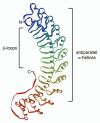ThANKs for the repeat: Intracellular pathogens exploit a common eukaryotic domain
- PMID: 22279611
- PMCID: PMC3265924
- DOI: 10.4161/cl.1.4.18738
ThANKs for the repeat: Intracellular pathogens exploit a common eukaryotic domain
Abstract
Bacterial pathogens are renowned cell biologists that subvert detrimental host responses by manipulating eukaryotic protein function. A select group of pathogens use a specialized type IV secretion system (T4SS) as a conduit to deliver an arsenal of proteins into the host cytosol where they interact with host proteins. The translocated "effectors" have garnered increased attention because they uncover novel aspects of host-pathogen interactions at the subcellular level. This review presents a group of effectors termed Anks that possess eukaryotic-like ankyrin repeat domains that mediate proteinprotein interactions and are critical for effector function. Interestingly, most known prokaryotic Anks are produced by bacteria that devote much of their time to replicating inside eukaryotic cells. Ank proteins represent a fascinating and versatile family of effectors exploited by bacterial pathogens and are proving useful as tools to study eukaryotic cell biology.
Figures

References
Grants and funding
LinkOut - more resources
Full Text Sources
